The story of Napier Lake Ranch
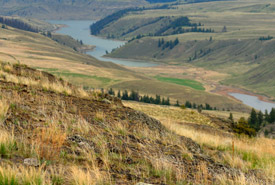
Napier Lake Ranch (Photo by Tim Ennis / NCC)
In 2014, the Nature Conservancy of Canada successfully conserved a portion of the Napier Lake Ranch to create the Napier Lake Ranch conservation area.
What follows is the story of the Jackson family, who carefully stewarded these lands for 40 years, and their dream of conserving their cherished ranchlands for now and forever.
The Emperor and Empress of Grass
Shortly after Agnes and Roy Jackson purchased the century-old Napier Lake Ranch in 1974, a neighbour said to them: “Always leave the land in better shape than when you found it.”
It was a piece of advice they have worked to follow for 40 years.
The grasslands on the ranch had been had heavily overgrazed by cattle and sheep belonging to previous landowners. When the Jacksons moved onto the ranch, the bunchgrass was only growing about three inches high — a mere shadow of the historic grasses that, “came up to a horse's belly,” as noted on a local plaque celebrating the Nicola Valley as an “Empire of Grass.” But after time, Agnes and Roy's careful range management encouraged the grasses to bounce back.
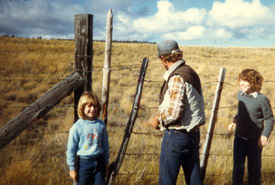
Roy Jackson and his daughters on Napier Lake Ranch (Photo courtesy of the Jackson family)
“When we bought the ranch, the grass was worn out,” says Agnes. “But the land responds to good stewardship.”
Today the bunchgrass once again reaches high enough to tickle the underside of the cattle that still range there, and a recent assessment by range agrologists confirmed that the grasslands of Napier Lake Ranch are in good to excellent condition.
“It’s been quite a challenge to bring it back,” says Agnes. “This piece of land sustained my family. It has been so good to us.”
Looking to the future
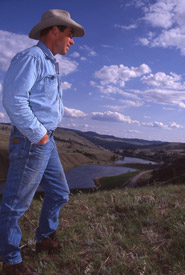
Roy Jackson at Napier Lake Ranch in 2001 (Photo by Rick Blacklaws)
It's been four decades since Agnes and Roy embarked on nurturing Napier Lake Ranch back to health and building a sustainable ranching business. Roy passed away a few years ago, and their two grown daughters have built careers and families away from the ranch. For Agnes, the time has come to look to what the future may hold for these grasslands.
“This is very productive grassland that has stood the test of time,” she says. “It has seen drought and conflict and fortune and failure, but it has always gone on.”
Looking around the Nicola Valley, it's easy to see that a healthy future is in no way certain for our native grasslands. Large intact expanses of grassland are being carved into smaller parcels and populated with homes, hobby farms and disruptive human activity. Industrial activity and incompatible agricultural practices are eroding the health of the native ecosystems. Wildlife is being pushed to the margins or simply disappears.
This is not the future Agnes wants for the land that has sustained her and her family for 40 years.
“We're here for such a short time and we use the land to survive,” she says. “To just cast it aside like an old shoe — I just can't do that.”
Instead, Agnes has chosen to work with the Nature Conservancy of Canada (NCC) to protect more than 526 hectares (1,300 acres) of Napier Lake Ranch's most productive grasslands.
“The key to making these grassland conservation projects succeed is to combine habitat protection with sensitive, sustainable land use,” says Barb Pryce, NCC's Southern Interior program director. “We have been so fortunate to work with some of British Columbia's most inspiring ranching families. Each of them has learned by direct experience how to build a productive ranching business that both relies on and enhances the native ecology of their land. Their knowledge is invaluable to our conservation efforts.”
In 2008 NCC partnered with another well-known Kamloops-area ranching family, the Froleks, to protect 3,155 hectares (7,800 acres) of grassland that the family had been tending for more than a century. In the East Kootenay, the organization has projects with Pine Butte Ranch and Thunder Hill Ranch, both family ranches that are committed to safeguarding their ecological as well as cultural heritage. All of these projects are structured to balance the protection of native plants and animals with ongoing, strategic cattle grazing. Done right, the two sides of the equation form a positive feedback loop that enhances the health of the grasslands and bolsters an important agricultural activity.
A biological boon
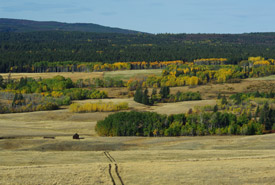
Napier Lake Ranch in the fall (Photo courtesy the Jackson family)
Napier Lake Ranch's credentials as a biodiversity hotspot cannot be understated. Sitting in the heart of the Nicola Valley, the ranch spans an important ecological transition zone from mid-elevation grasslands to Douglas-fir forests, linking a variety of habitats that provide movement corridors for animals shifting between summer and winter ranges. Gently rolling hills of bunchgrass provide cover for the abundance of birds and other small animals that flourish here. Hawks and falcons circle in the sky above, searching for movement in the waving grasses below. Cliffs and rocky outcrops are home to hibernating snakes and bats, while pockets of trembling aspen woodlands grow in the gullies, providing shade and niche habitat for wildlife.
“The wetlands that border the eastern edge of the property make these lands one of the most attractive locations for migratory waterbirds in this whole region,” says Barb.
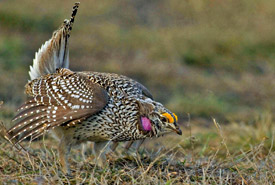
Male sharp-tailed grouse (Photo by Rick Howie)
Birds flourish in BC's native grasslands, and the ranch is particularly suited to provide prime habitat for these species. Situated in the Douglas Lake Plateau Important Bird Area, Napier Lake Ranch is a known breeding site for long-billed curlews and sharp-tailed grouse, both species at risk.
“In the spring hundreds of sandhill cranes come to the west side of the property,” says Agnes. “If someone were to build a house there and have a couple dogs and some llamas, the birds would be pushed aside. That's what is happening — they are driven into smaller and smaller spaces.”
The case for conservation
The conservation of Napier Lake Ranch has two very specific goals: to protect a large, intact swath of native grassland and to allow for the continued use of the lands to graze cattle.
“Our grasslands are disappearing at an alarming rate,” says Barb, “and as they are lost we are losing the species that depend on them. We can't make more native grasslands — we can only protect what we already have.”
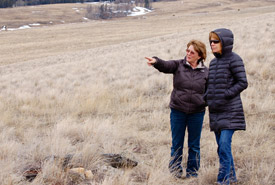
Agnes Jackson shows Linda Hannah of NCC around Napier Lake Ranch. (Photo by NCC)
NCC and Agnes want to help more people experience the beauty and vitality of the grasslands. Speeding past the open expanses while driving down the highway cannot truly impart the essence of the grasslands. Standing with both feet in the grasslands is the only way to experience the deep stillness and quietude of this contemplative landscape. It's a natural area that can easily be disturbed will vanish if not protected.
“We must tread lightly on the grasslands,” says Barb. “NCC will welcome walk-in access to this future conservation area. Grasslands are part of our natural heritage and everyone should know what it feels like to stand out under the big sky while the grasses blow around you and the hawks circle above.”
Agnes is hopeful that people will come out and experience the grasslands, especially those who live in the city and can so easily end up disconnected from nature. This is the legacy she and Roy truly hope to leave behind.
“Keeping large pieces of grassland intact is good for people's awareness,” says Agnes. “Walk through it, enjoy it and appreciate it. We're here for such a short time, but the land goes on forever. It means much more to us than we mean to it. So it's important to care for it and pass it on in a state that will carry on into the future and be looked after.”
Find out more about the Napier Lake Ranch conservation project >





